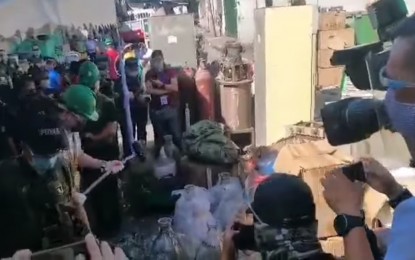
DESTROYED. PDEA chief Wilkins Villanueva (wearing PDEA hat) and Valenzuela Mayor Rex Gatchalian (2nd from left) lead the destruction of PHP904 million worth of illegal drugs in Valenzuela City on Thursday (Feb. 4, 2021). The destruction of the dangerous drugs is in compliance with the guidelines set on the custody and disposition of seized dangerous drugs pursuant to the Comprehensive Dangerous Drugs Act of 2002. (Screengrab from PTV video)
MANILA – The Philippine Drug Enforcement Agency (PDEA) destroyed on Thursday some PHP904 million worth of illegal drugs at the Green Plant Management, Incorporated (GPMI) in Barangay Punturin, Valenzuela City.
PDEA chief Wilkins Villanueva led the destruction of controlled precursors and essential chemicals (CPECs) and laboratory equipment used in the production of methamphetamine hydrochloride or shabu.
“The total value PHP904 million worth of precursors, essential chemicals, and laboratory equipment. ladies and gentlemen, this is the biggest destruction of precursors and control chemicals in the history of drug law enforcement,” Villanueva told reporters.
A total of 259,749 liters of liquid chemicals composed of hydrochloric acid, acetone, methyl ethyl ketone, sulfuric acid, acetic anhydride, acetic acid, ethanol, methanol, ammonia, isopropyl alcohol, cyclohexane, diethyl ether, and propylene glycol were destroyed through chemical treatment.
A total of 30,192,037 grams of solid chemicals consisting of red phosphorus, iodine, sodium hydroxide, acetamenophen, tartaric acid, potassium iodate, sodium acetate trihydrate, and ethyl maltol, sodium chloride, activated carbon and ionomer, were also destroyed.
Villanueva commended the efforts of different trial courts for the expeditious prosecution and disposition of drug cases that led to the prompt destruction of these chemicals and laboratory equipment that are no longer needed as evidence.
The destruction of the dangerous drugs is in compliance with the guidelines set on the custody and disposition of seized dangerous drugs required in Section 21, Article II of Republic Act 9165, or the Comprehensive Dangerous Drugs Act of 2002, and Dangerous Drugs Board Regulation No. 1, Series of 2002.
Villanueva also said the PDEA aims to promote a "balanced and humane" anti-drug campaign as it provides the public a more comprehensive platform of information on harm reduction.
“We now hit hard on the high-value targets, we do high impact operations by conducting dismantling of clandestine laboratories and drug dens, pero higit sa lahat (but most of all), we do the demand reduction by keeping away people from dangerous drugs,” he said.
He said what the agency is doing right now to implement the harm reduction and reintegration of drug personalities by implementing particular rehabilitation or reformation of these drug personalities.
Meanwhile, Villanueva also ordered to strengthen its campaign to block the bank accounts of members of drug syndicates who have been arrested during operations.
Earlier, PDEA and the Anti-Money Laundering Council (AMLC) joined forces to effectively implement the forfeiture of laundered money alleged to be proceeds of illegal drug activities.
Under an agreement, PDEA shall refer to the AMLC drug-related cases for financial investigation, and if warranted, filing of cases involving freeze order, civil forfeiture, and money laundering, accompanied with specified case documents that are admissible in court. (PNA)
